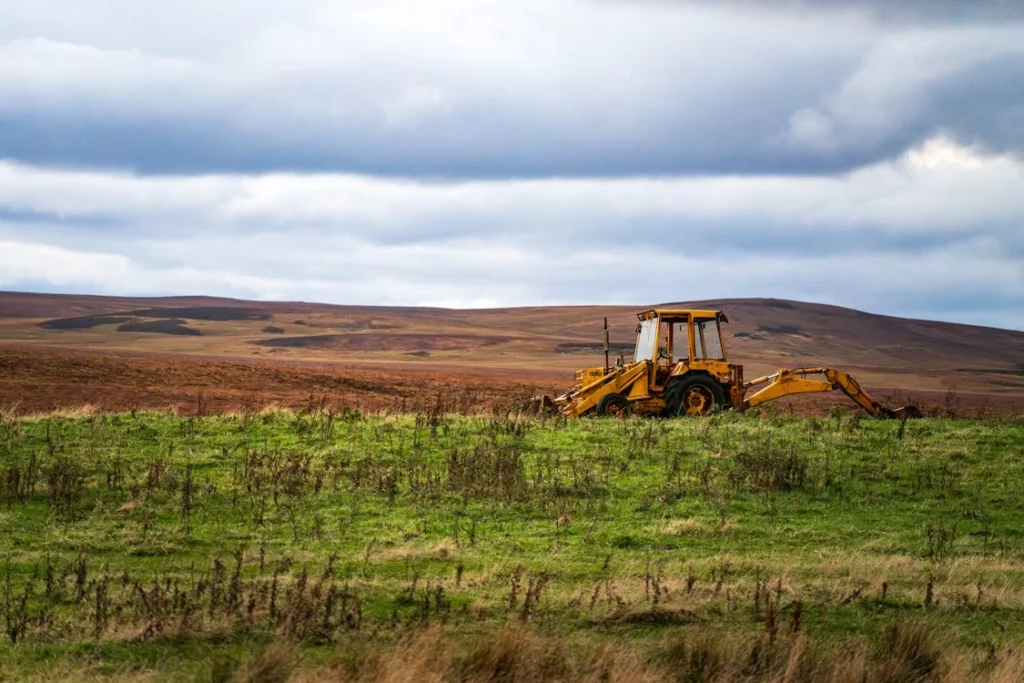5 Essential Tips to Prevent Excess Tractor Tyre Wear on Roads

Summary
Modern tractors travel longer distances on hard surfaces, demanding smarter tyre management. This blog explores practical ways to minimize road-induced wear through correct inflation, balanced loads, improved driving habits, and advanced agri tyre technology. Learn how TVS Eurogrip OHT’s engineered agricultural tyres help farmers enhance durability, efficiency, and sustainability across Europe and the United States.
Introduction:
Modern farming demands mobility. From one field to another, between towns, or along paved country roads, today’s tractors spend more time on asphalt than ever before. While this helps farmers operate efficiently, it also introduces a persistent challenge: excessive tyre wear.
Agricultural tyres are designed primarily for field traction and soil protection. But frequent road travel exposes them to surfaces they weren’t fully optimised for high-friction tarmac and concrete. The result? Faster tread erosion, greater fuel consumption, and higher replacement costs.
At TVS Eurogrip OHT, we’ve engineered tyres that perform exceptionally across field and road conditions. Drawing from our on-ground testing in Europe and North America, here are five expert-backed tips that can significantly reduce tyre wear, extend performance, and improve safety for your agricultural wheels and tyres.
Why Tractor Tyres Wear Faster on Roads
Tyre wear is not just a maintenance issue, it’s a complex interaction of heat, friction, load, and pressure. On loose soil, a tyre’s deep lugs sink slightly, spreading weight across a broad contact patch. On hard road surfaces, however, those same lugs scrub, flex, and overheat.
Here are the main reasons tyres deteriorate faster on roads:
- Increased surface friction: Asphalt and concrete create greater resistance than soil, eroding tread blocks faster.
- Excess heat generation: Continuous road use raises rubber temperatures beyond optimal range, reducing elasticity.
- Lug distortion: Hard contact flattens tread patterns, accelerating centre or shoulder wear.
- Imbalanced loads: Front-heavy implements or misaligned axles push weight unevenly on tyres.
- Improper pressure settings: Over- or under-inflated tyres wear unevenly, affecting both safety and efficiency.
When left unchecked, these factors can shorten tyre lifespan by up to 40%, directly impacting productivity and ROI.
Tip 1: Set the Right Inflation Pressure for Every Application
Nothing affects tyre life more than air pressure. The right inflation ensures the agricultural tyres maintain optimal shape, distribute load evenly, and manage heat effectively.
- In the field: Lower pressures (typically 10–15 psi or 0.7–1 bar) widen the footprint, improving traction and reducing soil compaction.
- On the road: Higher pressures (18–25 psi or 1.3–1.7 bar) minimise flexing and rolling resistance, cutting down on internal heat.
A simple rule: every 10% drop below the recommended pressure can cut tyre life by 15%.
Before hitting the road, check and adjust pressures with a reliable gauge, ideally when tyres are cool.
Pro Insight from TVS Eurogrip OHT:
Our advanced agri tyres are compatible with modern Tyre Pressure Monitoring Systems (TPMS). These real-time digital sensors track pressure and temperature, alerting you before issues arise, a crucial step for large-scale European and American farms where tractors operate continuously across mixed terrains.
Tip 2: Maintain Proper Load Balance and Axle Alignment
Uneven load distribution is a silent killer of tyre life. If the tractor’s weight or implement load isn’t balanced correctly, one tyre may carry more weight than the others, creating irregular tread wear.
Here’s how to maintain proper load balance:
- Check axle alignment every 500 working hours or after impacts (like potholes or stones). Misaligned axles cause feathering, diagonal or uneven lug wear patterns.
- Distribute ballast properly. For front loaders, ensure counterweights are correctly installed to reduce front-axle stress.
- Equalise dual-tyre setups. Both tyres in a pair must share identical inflation pressures to carry loads evenly.
Improper alignment can cost up to 20–25% in premature tyre wear. Regular inspections and periodic recalibrations help avoid uneven erosion and protect your investment.
Tip 3: Drive Smart | Manage Speed, Turns, and Braking
Driving habits directly determine tyre longevity. Modern tractors are capable of higher transport speeds, but pushing tyres beyond their rated limits on hard roads accelerates heat build-up and wear.
Here’s what experienced operators and engineers recommend:
- Avoid rapid acceleration. Sudden torque application grinds away tread edges.
- Maintain consistent speeds. Keep within the tyre’s rated limit, generally below 50 km/h (30 mph) for most agricultural radials.
- Use engine braking on slopes. Reduces heat and friction from wheel brakes.
Plan smoother cornering. Sharp turns cause lateral scrubbing, especially damaging for rear tyres. - Avoid long idle periods on hot tarmac. Stationary friction in heat increases deformation stress.
Did you know?
Each 10°C increase in tyre temperature can reduce service life by around 10%. Over a season, that adds up to significant financial loss.
At TVS Eurogrip OHT, our new agricultural tires use advanced rubber compounds that withstand higher road heat and friction, ensuring consistent grip and tread retention even under continuous transport duty.
Tip 4: Rotate, Inspect, and Record Tyre Health
A proactive inspection schedule can catch problems before they escalate. Unlike car tyres, tractor tyres experience both torque stress and lateral loads, especially in 4WD and heavy-tillage units. That’s why rotation and documentation are crucial.
Recommended rotation interval:
- Every 1,000 operating hours or once per season (whichever comes first).
- Rotate between front and rear if wear patterns differ significantly.
Inspection checklist:
- Cracks between tread lugs
- Cuts or bulges on sidewalls
- Uneven tread depth between inner and outer edges
- Rim leaks or damaged valve stems
- Embedded stones or nails (common in mixed-surface work)
Keep a digital or manual tyre logbook noting inflation, operating hours, terrain type, and observed wear. These insights help predict replacement timing and identify mechanical issues early, aligning with smart-farming practices widely adopted across Europe and the US.
Tip 5: Choose Tyres Built for Both Field and Road
Selecting the right agricultural wheels and tyres can make all the difference. Traditional deep-lug tyres perform well on soil but wear quickly on roads. Instead, opt for hybrid tread designs built for dual use.
When selecting tyres, consider these features:
- Special tread compounds: Heat- and abrasion-resistant rubber reduces highway wear.
- Optimised lug geometry: Minimises vibration and “heel-toe” wear on asphalt.
- Flexible sidewalls: Absorb shock during fieldwork yet remain firm on roadways.
- Self-cleaning design: Prevents soil carryover, improving safety and efficiency.
TVS Eurogrip OHT’s premium Agri Radial Hybrid Series incorporates these elements, providing enhanced road stability without compromising traction in the field. Designed through European test cycles, these tyres offer up to 30% longer lifespan on hard surfaces while retaining field agility, making them ideal for contractors, cooperatives, and mixed-application users.
Bonus: Store and Maintain Tyres Correctly Between Seasons
Proper storage extends tyre life as effectively as careful driving.
Follow these best practices:
- Store indoors. Stay away from direct sunlight and ozone sources (like motors or welders).
- Clean before storage. Wash off fertiliser, oil, or chemical residues that corrode rubber.
- Position upright on pallets, not stacked horizontally.
- Avoid contact with fuel or solvents. Even trace contact can weaken rubber compounds.
- Reinflate before reuse and check sidewalls for cracking or flat spots.
Correct off-season maintenance can extend tyre usability by up to two years, helping lower the total cost of ownership, a major consideration for commercial farms and custom operators.
The Role of Technology in Extending Tyre Life
Smart farming isn’t limited to machinery, it extends to tyres. Digital monitoring now provides real-time insight into performance metrics that previously went unnoticed.
Advanced agricultural tires equipped with sensors track:
- Internal air pressure and temperature
- Load distribution
- Operating hours and terrain types
- Tyre slip and traction efficiency
Through telematics integration, these data points are sent to dashboards or mobile apps, allowing operators to anticipate wear patterns and plan replacements strategically.
Conclusion
The life of a tractor tyre is determined as much by the road as by the field. By optimising pressure, balancing loads, driving responsibly, maintaining inspections, and investing in high-quality agricultural tyres, you can dramatically extend tyre lifespan and productivity.
As a trusted manufacturer with decades of global expertise, TVS Eurogrip OHT continues to design farm and agricultural tyres that meet the evolving needs of modern agriculture, combining durability, innovation, and sustainability. When tyres last longer, farms run smoother, costs drop, and the planet benefits.
Explore the full range of TVS Eurogrip OHT agri tyres engineered for superior road and field performance across Europe and the United States.
FAQs
Q1. Why do tractor tyres wear faster on roads than in fields?
Agricultural tyres are built for soft ground traction, not high-friction tarmac. Hard surfaces generate excess heat and abrasion, leading to faster tread wear.
Q2. What’s the ideal tyre pressure for road driving?
Most tyres need 20–25% higher pressure on roads compared to fieldwork. Always refer to manufacturer guidelines and use a calibrated gauge.
Q3. How often should I rotate tractor tyres?
Every 1,000 hours or once per farming season. Rotation ensures even tread wear, especially for 4WD and heavily loaded tractors.
Q4. Which tyres are best for mixed road and field use?
Hybrid agri tyres like the TVS Eurogrip OHT Radial Hybrid Series combine reinforced tread compounds and heat-resistant sidewalls for both conditions.
Q5. Can digital tyre monitoring really extend lifespan?
Yes. Telematics and TPMS sensors prevent underinflation, detect heat buildup, and alert users before critical damage occurs, reducing unexpected downtime.
Q6. Do better tyres help reduce fuel costs?
Properly inflated and maintained tyres lower rolling resistance, improving fuel economy by up to 5%, saving both money and emissions.

Maximizing Guest Satisfaction Through Professional Vacation Rental Cleaning

A Complete Guide to Dumpster Rental: Efficient Waste Management for Projects of Every Size

Comprehensive Strategies and Best Practices for Fire Mitigation to Protect Lives, Property, and the Environment in Modern Residential and Commercial Settings

Onsite Tire Change in Ottawa : Safe Fast & Professional Tire Services

Accelerating drug discovery through the DEL-ML-CS approach

ISOBUS + FieldBee: Smarter Machines, Better Results

Styling Your Garden Dining Setup for Every Season

Transforming Modern Agriculture with Innovative Hydroponics and Greenhouse Solutions








